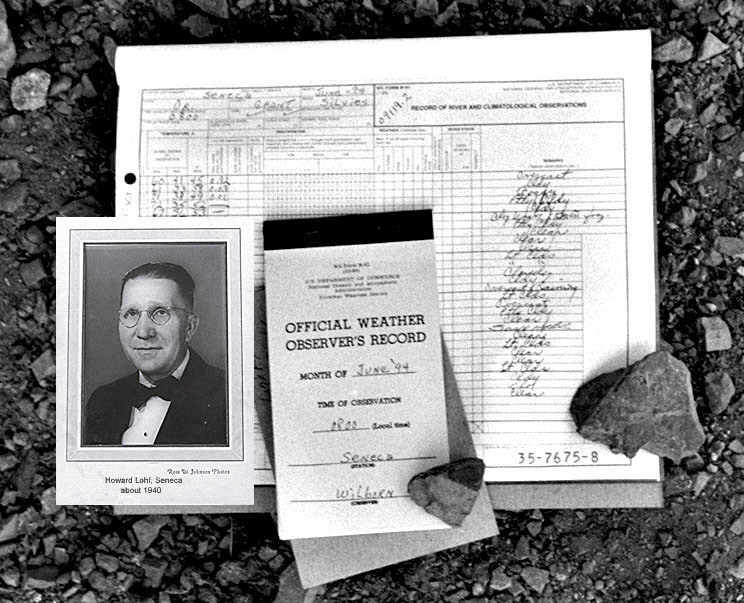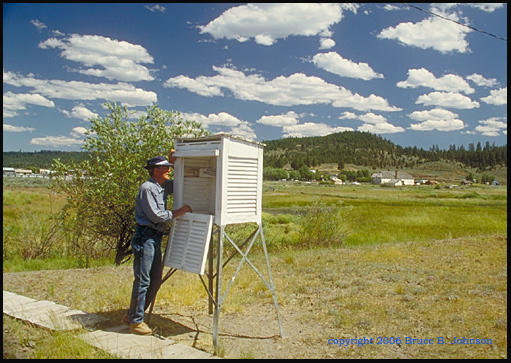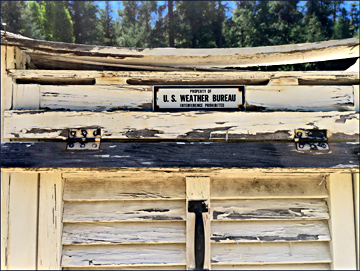

My full historical story of Seneca in the 1930s, and specifically Mr. Lohf's historic weather observations that frigid day in the winter of 1933, were published in four main places: (1) the Burns Times-Herald newspaper on February 8th, 1995; (2) Cascades East Magazine, a quarterly published by Sun Publications in Bend, Oregon, Winter 94-95 edition; (3) The Eugene Register-Guard newspaper, February 5th, 1995; and (4) The Blue Mountain Eagle newspaper*, week of February 6, 1995. More, recently, a portion of the original story was re-published on-line within the Oregon Climate Service's website.
 Seneca's
present weather station and its long-time Cooperative Observer,
Mr. John Saunders, 1995.
Seneca's
present weather station and its long-time Cooperative Observer,
Mr. John Saunders, 1995.
"With all of the state-of-the-art
technology associated with the modernization of the National Weather
Service, there remains a program administered by the Weather Service
that has stayed virtually unchanged since its inception over a
hundred years ago. This is the Cooperative Weather Observer Program
where 11,700 volunteer
weather observers across the country record daily temperature
and precipitation data. Some also record or report additional
information such as soil temperature, evaporation and wind movement,
agricultural data, water equivalent of snow on the ground, river
stages, lake levels, atmospheric phenomena, and road hazards.
Many Cooperative Stations in the United States have been collecting
weather data from the same location for over 100 years.
The first extensive network of cooperative stations was set up
in the 1890's as a result of an act of congress in 1890 that established
the Weather Bureau, but many of its stations began operation long
before that time. John Companius Holm's weather records, taken
without the benefit of instruments in 1644 and 1645, were the
earliest known observations in the United States. Subsequently
many persons, including George Washington, Thomas Jefferson, and
Benjamin Franklin, maintained weather records. Jefferson maintained
an almost unbroken record of weather observations between 1776
and 1816 and Washington took his last weather observation just
a few days before he died. Two of the most prestigious awards
given to Cooperative Weather Observers are named after Holm and
Jefferson. Because of it's many decades of relatively stable operation,
high station density, and high proportion of rural locations,
the Cooperative Network has been recognized as the most definitive
source of information on U.S. climate trends for temperature and
precipitation. Cooperative Stations form the core of the U.S.
Historical Climate Network (HCN) and the U.S. Reference Climate
Network. Image
note: classic thermometer
box, 2018, much-weathered; it's located at the site of the former
Ochoco Ranger Station (station is now demolished but box remains)
Equipment to gather these data is provided and maintained by the
National Weather Service and data forms are sent monthly to the
National Climatic Data Center (NCDC) in Asheville, North Carolina,
where data are digitized, quality controlled, and subsequently
archived. Volunteer weather observers regularly and conscientiously
contribute their time so that their observations can provide the
vital information needed. These data are invaluable in learning
more about the floods, droughts, and heat and cold waves which
inevitably affect everyone. They are also used in agricultural
planning and assessment, engineering, environmental-impact assessment,
utilities planning, and litigation and play a critical role in
efforts to recognize and evaluate the extent of human impacts
on climate from local to global scales. Many Cooperative Weather
Observers report daily precipitation to River Forecast Centers
in support of the National Weather Service Hydrology Program.
Volunteer weather observers conscientiously contribute their time
so that observations can provide the vital information needed.
These data are invaluable in learning more about the floods, droughts,
heat and cold waves affecting us all. The data are also used in
agricultural planning and assessment, engineering, environmental-impact
assessment, utilities planning, and litigation. COOP data plays
a critical role in efforts to recognize and evaluate the extent
of human impacts on climate from local to global scales."
Page last revised 9/25/2022